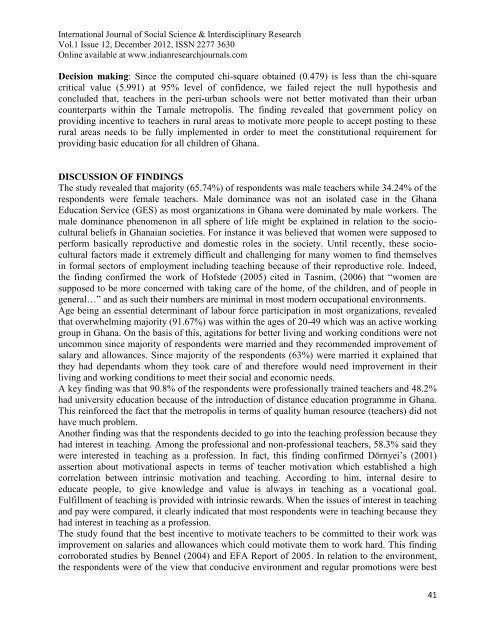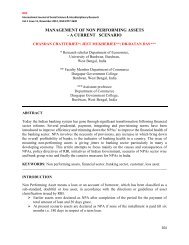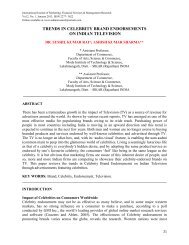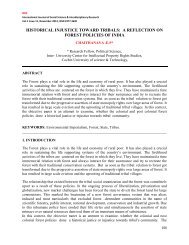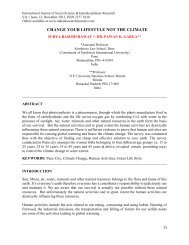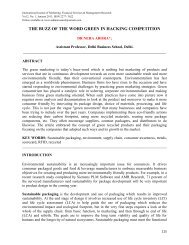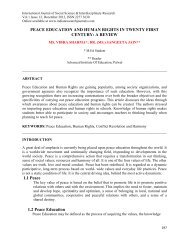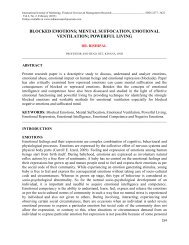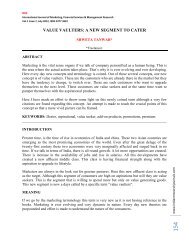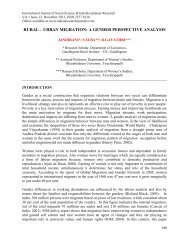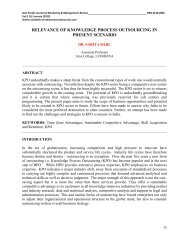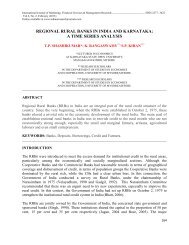teacher motivation and quality education delivery: a study of public ...
teacher motivation and quality education delivery: a study of public ...
teacher motivation and quality education delivery: a study of public ...
Create successful ePaper yourself
Turn your PDF publications into a flip-book with our unique Google optimized e-Paper software.
International Journal <strong>of</strong> Social Science & Interdisciplinary Research<br />
Vol.1 Issue 12, December 2012, ISSN 2277 3630<br />
Online available at www.indianresearchjournals.com<br />
Decision making: Since the computed chi-square obtained (0.479) is less than the chi-square<br />
critical value (5.991) at 95% level <strong>of</strong> confidence, we failed reject the null hypothesis <strong>and</strong><br />
concluded that, <strong>teacher</strong>s in the peri-urban schools were not better motivated than their urban<br />
counterparts within the Tamale metropolis. The finding revealed that government policy on<br />
providing incentive to <strong>teacher</strong>s in rural areas to motivate more people to accept posting to these<br />
rural areas needs to be fully implemented in order to meet the constitutional requirement for<br />
providing basic <strong>education</strong> for all children <strong>of</strong> Ghana.<br />
DISCUSSION OF FINDINGS<br />
The <strong>study</strong> revealed that majority (65.74%) <strong>of</strong> respondents was male <strong>teacher</strong>s while 34.24% <strong>of</strong> the<br />
respondents were female <strong>teacher</strong>s. Male dominance was not an isolated case in the Ghana<br />
Education Service (GES) as most organizations in Ghana were dominated by male workers. The<br />
male dominance phenomenon in all sphere <strong>of</strong> life might be explained in relation to the sociocultural<br />
beliefs in Ghanaian societies. For instance it was believed that women were supposed to<br />
perform basically reproductive <strong>and</strong> domestic roles in the society. Until recently, these sociocultural<br />
factors made it extremely difficult <strong>and</strong> challenging for many women to find themselves<br />
in formal sectors <strong>of</strong> employment including teaching because <strong>of</strong> their reproductive role. Indeed,<br />
the finding confirmed the work <strong>of</strong> H<strong>of</strong>stede (2005) cited in Tasnim, (2006) that “women are<br />
supposed to be more concerned with taking care <strong>of</strong> the home, <strong>of</strong> the children, <strong>and</strong> <strong>of</strong> people in<br />
general…” <strong>and</strong> as such their numbers are minimal in most modern occupational environments.<br />
Age being an essential determinant <strong>of</strong> labour force participation in most organizations, revealed<br />
that overwhelming majority (91.67%) was within the ages <strong>of</strong> 20-49 which was an active working<br />
group in Ghana. On the basis <strong>of</strong> this, agitations for better living <strong>and</strong> working conditions were not<br />
uncommon since majority <strong>of</strong> respondents were married <strong>and</strong> they recommended improvement <strong>of</strong><br />
salary <strong>and</strong> allowances. Since majority <strong>of</strong> the respondents (63%) were married it explained that<br />
they had dependants whom they took care <strong>of</strong> <strong>and</strong> therefore would need improvement in their<br />
living <strong>and</strong> working conditions to meet their social <strong>and</strong> economic needs.<br />
A key finding was that 90.8% <strong>of</strong> the respondents were pr<strong>of</strong>essionally trained <strong>teacher</strong>s <strong>and</strong> 48.2%<br />
had university <strong>education</strong> because <strong>of</strong> the introduction <strong>of</strong> distance <strong>education</strong> programme in Ghana.<br />
This reinforced the fact that the metropolis in terms <strong>of</strong> <strong>quality</strong> human resource (<strong>teacher</strong>s) did not<br />
have much problem.<br />
Another finding was that the respondents decided to go into the teaching pr<strong>of</strong>ession because they<br />
had interest in teaching. Among the pr<strong>of</strong>essional <strong>and</strong> non-pr<strong>of</strong>essional <strong>teacher</strong>s, 58.3% said they<br />
were interested in teaching as a pr<strong>of</strong>ession. In fact, this finding confirmed Dörnyei‟s (2001)<br />
assertion about <strong>motivation</strong>al aspects in terms <strong>of</strong> <strong>teacher</strong> <strong>motivation</strong> which established a high<br />
correlation between intrinsic <strong>motivation</strong> <strong>and</strong> teaching. According to him, internal desire to<br />
educate people, to give knowledge <strong>and</strong> value is always in teaching as a vocational goal.<br />
Fulfillment <strong>of</strong> teaching is provided with intrinsic rewards. When the issues <strong>of</strong> interest in teaching<br />
<strong>and</strong> pay were compared, it clearly indicated that most respondents were in teaching because they<br />
had interest in teaching as a pr<strong>of</strong>ession.<br />
The <strong>study</strong> found that the best incentive to motivate <strong>teacher</strong>s to be committed to their work was<br />
improvement on salaries <strong>and</strong> allowances which could motivate them to work hard. This finding<br />
corroborated studies by Bennel (2004) <strong>and</strong> EFA Report <strong>of</strong> 2005. In relation to the environment,<br />
the respondents were <strong>of</strong> the view that conducive environment <strong>and</strong> regular promotions were best<br />
41


